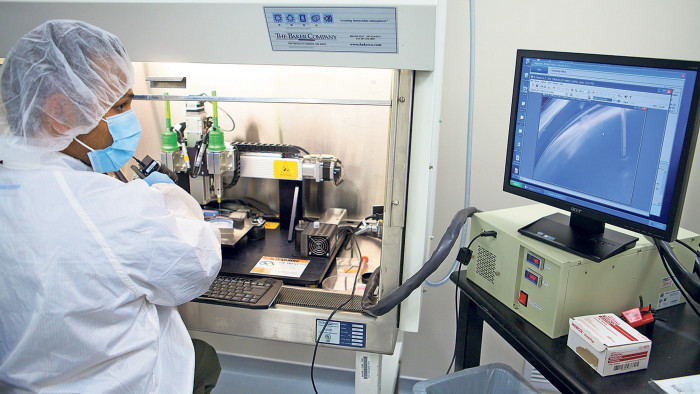Printing whole organs remains a long way off

Roula Khalaf, Editor of the FT, selects her favourite stories in this weekly newsletter.
Three dimensional printing is already being used to manufacture everything from simple plastic figurines to complex metal aircraft parts. But the industry has a bigger target in its sights: creating living human tissues layer by layer.
Bioprinting offers the ability to accelerate drug development and testing and lower the cost. One day it may also produce replacement organs for patients in need of a transplant. The technology works by taking a patients’ cells to form a bioink, which is then placed into cartridges that contain a syringe fitted with an extrusion nozzle for printing.
The bioprinter deposits a pattern of cells in layers, interspersed with a water-based gel — called a hydrogel — that is used as a kind of scaffolding for the cells. The printed tissue is then left to grow naturally, and the hydrogel removed. Scott Collins, chief technology officer at US start-up TeVido Biodevices, a 3D bioprinting company, says: “We’re putting the cells in the right place, but then biology takes over and helps it develop into the tissues.”
While conventional 3D printing of plastics has been around since the 1980s, bioprinting is in the early stages of development. The first patents for bioprinters and their materials were filed only in the past 10 years. Currently, printed tissues are mainly being used for research, but several companies are attempting to commercialise the production of bioprinted tissues.
US-based start-up Organovo, the world’s first publicly traded 3D bioprinting company, has developed living liver tissue for medical research and clinical trials.
This year, the company has already signed research partnerships with Merck & Co, the pharmaceutical company, to use its liver tissue service, and L’Oréal, the cosmetics group, to develop 3D bioprinted skin.
Tevido Biodevices, a US start-up, is using 3D bioprinting to reconstruct a woman’s nipple tissue following breast cancer surgery. The company raised $30,000 through crowdfunding this year to patent its technology, which it is at early prototyping stage. It hopes to launch its product in about six years, once it has conducted clinical trials and received the regulatory go-ahead.
Bioprinting could save pharmaceutical companies a lot of money, according to Fanny Sie of MaRS Innovation, a Toronto-based company. The company has developed the PrintAlive Bioprinter, which can print skin that could be used to treat people with large scale burns. The printed tissues could be used by pharmaceutical companies to test the toxicity of new drugs, and help them decide if it is worth starting costly animal and then human clinical trials.
“Bioprinting is a very active area of development in terms of pre-drug screening. If you have 20 drugs, before you start testing on animals, you can at least get it down to five with this new screening method,” she says.
3D printing accelerates the tissue-making process and makes it more precise. Previously, scaffolds were created by hand — or 3D printed — and then the cells were positioned by a handheld pipette.
Ms Sie says: “The hope is that there is efficiency in placing them together closer than they would be without the printer, so the interactions can happen faster. We’re not trying to take over mother nature, we’re just trying to facilitate the interaction.”
Twitter Q&A

What is an inventor’s greatest challenge? How do you protect ideas and turn them into money?
Join the chat using #FTinvent on Thursday 11 June 5-6pm London time (6-7pm Paris)
Printing whole organs remains a long way off, however. “I think the timelines have been hyped up a lot,” says Dr Collins. “People have talked about print-on-demand hearts or kidneys in five to 10 years, but that’s unrealistic. We might see it in 20 to 30 years.”
One of the main obstacles to printing entire organs has been the need for vascularisation, the 3D printing of veins and arteries, that provide nutrients to keep the organs alive.
A team of Harvard university bioengineers has made progress in this area, revealing this year a 3D printing method that creates functional vascular networks — a holy grail problem of tissue engineering and regenerative medicine.
Jennifer Lewis, who led the team at Harvard, says she believes it is a “foundation step” towards printing whole organs, but stresses that the industry is very far away from realising this dream.
“The human body is composed of hundreds of types of cell, many of which do not have commercial or clinically relevant sources. This challenge will require advances in stem cell biology and cell banking,” says Prof Lewis.
Brian Derby, professor of materials science at the University of Manchester, says it is not clear that entire organs could ever be printed. “I think there are a lot of issues. It’s not a given that it would be a perfect replacement.”
He says the industry is likely to instead focus on patch-sized tissues, that could work like mini organs.
“After a heart attack you have a lot of scar tissue, so you might find ways of making patches that could augment organs. You are not going to be able to print a whole heart, kidney or liver at the moment,” says Prof Derby.
Even if science does reach this point, many other challenges will have to be resolved. One hurdle is regulation, says David Williams, professor of healthcare engineering at the University of Loughborough.
“It’s going to be a very long journey to satisfying the regulator that these things are safe,” he says.
Comments